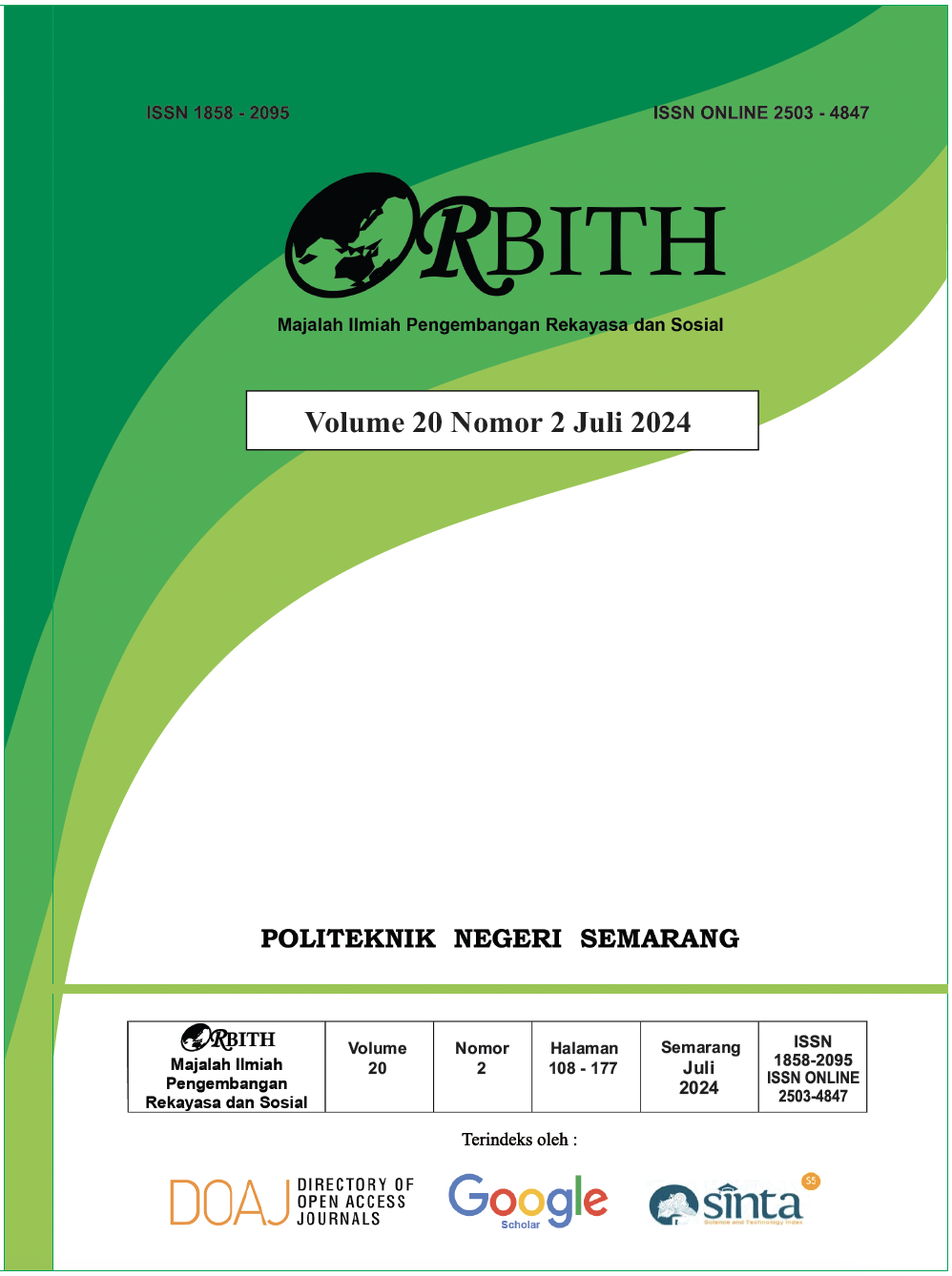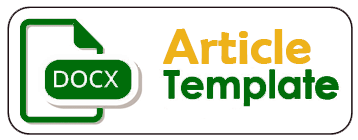PRINTER BRAILLE UNTUK PENYANDANG DISABILITAS TUNANETRA
DOI:
https://doi.org/10.32497/orbith.v20i2.5777Keywords:
Printer Braille, Tunanetra, Huruf Braille, Arduino Uno, BluetoothAbstract
Abstrak
Printer Braille untuk Penyandang Disabilitas Tunanetra merupakan alat bantu penyandang tunanetra untuk membaca dan mendapatkan informasi melalui huruf braille. Pengguna memasukkan teks yang ingin dicetak melalui aplikasi Kodular "Printer Braille" menggunakan Smartphone. Smartphone terkoneksi dengan mikrokontroller melalui bluetooth. Mikrokontroller Arduino Uno akan menggerakan motor servo menuju titik pertama huruf braille yang akan dicetak. Motor stepper akan bergerak beriringan dengan motor servo untuk mencetak huruf braille sesuai pesan yang diterima. Jarum pada motor servo akan membentuk huruf braille sesuai dengan posisi reglet braille. Hasil cetakan dari printer ini dapat berupa kalimat, huruf, atau angka timbul yang disebut relief huruf braille. Hasil pengujian menunjukkan bahwa pencetakan abjad A-Z dan teks POLINES EK 3C memiliki kesesuaian sebesar 98% dan pencetakan angka 0-9 dan teks "33219213"memiliki kesesuaian hasil sebesar 100%.
Abstract
Braille Printer for blind people is a tool that allows blind peopleto read and get information through braille. The user enters the text to be printed through the Kodular ”˜Braille Printer”™ application using a Smartphone. The smartphone is connected to the microcontroller via Bluetooth. The Arduino Uno microcontroller will move the servo motor toward the first point of the braille letters to be printed. The stepper motor will move along with the servo motor to print braille letters according to the message received. The needle on the servo motor will form braille letters according to the position of the braille reglet. The printout of this printer can be in the form of sentences, letters, or embossed numbers called relief braille letters. The test results show that printing the alphabet A and the text POLINES EK 3C has a conformity of 98%, and printing the numbers 0-9 and the text ”˜33219213”™ has a conformity result of 100%.
References
Ardiansyah. 2017. Rancang Bangun Sistem Konversi Teks Ke Huruf Braile Untuk Alat Bantu Baca Bagi Tunanetra Menggunakan Arduino Uno. Jurusan Teknik Informatika, Fakultas Sain dan Teknologi, Universitas Isalam Negeri Alaudin Makasar.
Byrd, Greg. 2016. Tactile Digital Braille Display. Computer, 49(11), 88-90, ISSN 0018-9162, Institute of Electrical and Electronics Engineers (IEEE), https://doi.org/10.1109/mc.2016.327
Denny Prabowo S, Rika Rokhana, Paulus Susetyo W. 2018. Rancang Bangun Alat Bantu Membaca SMS Untuk Penderita Tuna Netra Dengan Menggunakan Hurufbraille Berbasis Mikrokontroler. Jurusan Teknik Elektronika, Politeknik Elektronika Negeri Surabaya- ITS.
Diana, I Putu Agus Padma, Agung, I Gusti Agung Putu Raka, Rahardjo, Pratolo. 2018. Perancangan ModulPembelajaran Huruf Braille Berbasis Mikrokontroler Untuk Membantu Proses Belajar Disabilitas Netra. Jurnal SPEKTRUM, 5(1), 5, ISSN 2684-9186, Universitas Udayana, https://doi.org/10.24843/spektrum.2018.v05.i01.p03
Handayani, Yanolanda Suzantry, & Mardiana, Yessi .2018. Kendali Robot Bluetooth Dengan Smartphone Android Berbasis Arduino Uno. ILKOM Jurnal Ilmiah, 10(3), 331-337, ISSN 2548-7779, Universitas Muslim Indonesia, https://doi.org/10.33096/ilkom.v10i3.363.331-337
Hemanth, A V, Bharadwaj, K Sai, Prasanthi, V, Harikumar, M.E., & Gini, J Rolant. 2020. Arduino and Solenoid Valve-Based Text to Braille Converter. 2020 Third International Conference on Smart Systems and Inventive Technology (ICSSIT), IEEE, https://doi.org/10.1109/icssit48917.2020.9214158
Jonnatan Arroyo 1, Ramiro Velázquez 1, Mehdi Boukallel 2, Nicola Ivan Giannoccaro 3, Paolo Visconti 3 (2020). Design and Implementation of a Low-Cost Printer Head for Embossing Braille Dots on Paper. International Journal of Emerging Trends in Engineering Research, 8(9), 6183-6190, ISSN 2347-3983, The World Academy of Research in Science and Engineering, https://doi.org/10.30534/ijeter/2020/206892020
Maruzi, Muchlis, Nofriadi, Nofriadi, & Syahputra, Abdul Karim .2021. Alat Pengenalan Huruf Braille untuk Murid Tunanetra dengan Kontrol Android. JUTSI (Jurnal Teknologi dan Sistem Informasi), 1(3), 261-266, ISSN 2774-9029, LPPM STMIK Royal, https://doi.org/10.33330/jutsi.v1i3.1338
Mulik, Omkar, Gulve, Kewal, Kathe, Siddhesh, & K., Prof. Nagmani. 2017. Braille Printer. IJARCCE, 6(4), 43-47, ISSN 2278-1021, Tejass Publishers, https://doi.org/10.17148/ijarcce.2017.6409
Rezky Pratiwi Y. 2018. Perancangan Alat Peraga Pengenalan Huruf Braille Berbasis Mikrokontroller. Jurusan Teknik Informatika, Fakultas Sain dan Teknologi, Universitas Isalam Negeri Alaudin Makasar.
Sarifudin, Manshur, Manshur, Tirtana, Angga. 2018. Penggunaan Komunikasi Bluetooth Pada Smartphone Android Untuk Pengiriman Data Pada Jam Digital Berbasis Arduino. Jurnal ELTIKOM, 1(2), 102-112, ISSN 2598-3288, P3M Politeknik Negeri Banjarmasin, https://doi.org/10.31961/eltikom.v1i2.22
Singh, Rajesh, Gehlot, Anita, & Singh, Bhupendra. 2019. Servo Motor Control with Arduino_1.1 Package. Arduino and SCILAB based Projects, 69-72, BENTHAM SCIENCE PUBLISHERS, https://doi.org/10.2174/9789811410925119010007
Vyas, Salonie, Chaudhari, Umang, Chinmay, V., & Thakare, Bhushan. 2016. Access Control Application using Android Smartphone, Arduino and Bluetooth. International Journal of Computer Applications, 142(9), 16-20, ISSN 0975-8887, Foundation of Computer Science,https://doi.org/10.5120/ijca2016909902
Wagh et al. 2016. E-Braille-a self-learning Braille device. Twenty Second National Conference on Communication (NCC), 2016, pp. 1-6. doi: 10.1109/NCC.2016.7561162.
Zaenal Muttaqien. 2015. Mesin Ketik Huruf Braille Elektronik Berbasis Mikrokontroller AT mega16. Jurusan Pendidikan Teknik Elektronika, Fakultas Teknik, Universitas Negeri Yogyakarta.
Downloads
Published
Issue
Section
License
Authors who publish with this journal agree to the following terms:Authors retain copyright and grant the journal right of first publication with the work simultaneously licensed under a Creative Commons Attribution License that allows others to share the work with an acknowledgement of the work's authorship and initial publication in this journal.
Authors are able to enter into separate, additional contractual arrangements for the non-exclusive distribution of the journal's published version of the work (e.g., post it to an institutional repository or publish it in a book), with an acknowledgement of its initial publication in this journal.
Authors are permitted and encouraged to post their work online (e.g., in institutional repositories or on their website) prior to and during the submission process, as it can lead to productive exchanges, as well as earlier and greater citation of published work (See The Effect of Open Access).






